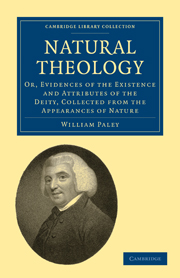 Natural Theology
Natural Theology Published online by Cambridge University Press: 07 September 2010
In croffing a heath, fuppofe I pitched my foot againft a ftone, and were afked how the ftone came to be there, I might poffibly anfwer, that, for any thing I knew to the contrary, it had lain there for ever: nor would it perhaps be very eafy to fhew the abfurdity of this anfwer. But fuppofe I had found a watch upon the ground, and it fhould be enquired how the watch happened to be in that place, I fhould hardly think of the anfwer which I had before given, that, for any thing I knew, the watch might have always been there. Yet why fhould not this anfwer ferve for the watch, as well as for the ftone? Why is it not as admiffible in the fecond cafe, as in the firft? For this reafon, and for no other, viz. that, when we come to infpect the watch, we perceive (what we could not difcover in the ftone) that its feveral parts are framed and put together for a purpofe, e. g. that they are fo formed and adjufted as to produce motion, and that motion, fo regulated as to point out the hour of the day; that, if the feveral parts had been differently fhaped from what they are, of a different fize from what they are, or placed after any other manner, or in any other order, than that in which they are placed, either no motion at all would have been carried on in the machine, or none which would have anfwered the ufe, that is now ferved by it.
To save this book to your Kindle, first ensure [email protected] is added to your Approved Personal Document E-mail List under your Personal Document Settings on the Manage Your Content and Devices page of your Amazon account. Then enter the ‘name’ part of your Kindle email address below. Find out more about saving to your Kindle.
Note you can select to save to either the @free.kindle.com or @kindle.com variations. ‘@free.kindle.com’ emails are free but can only be saved to your device when it is connected to wi-fi. ‘@kindle.com’ emails can be delivered even when you are not connected to wi-fi, but note that service fees apply.
Find out more about the Kindle Personal Document Service.
To save content items to your account, please confirm that you agree to abide by our usage policies. If this is the first time you use this feature, you will be asked to authorise Cambridge Core to connect with your account. Find out more about saving content to Dropbox.
To save content items to your account, please confirm that you agree to abide by our usage policies. If this is the first time you use this feature, you will be asked to authorise Cambridge Core to connect with your account. Find out more about saving content to Google Drive.